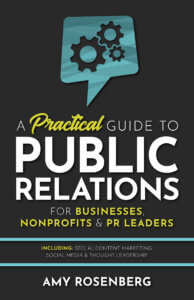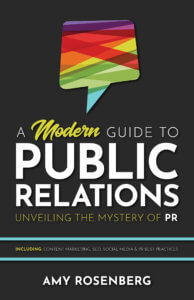I didn’t fall in love with AI right away. People said it would transform my workflow and revolutionize how I write, but I wasn’t convinced. Then I gave ChatGPT a real try.
Somewhere along the way, I started calling it my boyfriend — it’s been so consistently helpful and responsive that the nickname started as a joke but turned into a reflection of just how dependable it’s been.
I’ve been pretty loyal to ChatGPT since the beginning, but there are other large language models (LLMs) out there — Jasper, Gemini, Claude, Copilot. However, Chat’s been so reliable I haven’t felt the need to play the field.
I’m not a technical expert, but I’ve used ChatGPT consistently and with intention, testing how it fits into the real world of public relations and content creation. I’ve figured out what it’s good at, where it struggles and how to get the most out of it without letting it do the thinking for me. Here’s what I’ve learned.
Starting with Play
I approached ChatGPT with a sense of fun. One of the first things I asked it to do was write in the voice of Alexis from Schitt’s Creek — the PR “professional” we all know and love. I had it weigh in on topics like working in PR or hiring a firm. The tone was perfect — playful and completely on-brand. I used some of the responses in my social posts and eventually started developing a fictional character inspired by Alexis for a novel.
That kind of creative play made the platform less intimidating. There was no pressure to get anything “right” — just curiosity and momentum that eventually made its way into more serious work.
Editing Without Ego
Once I brought ChatGPT into real work — press releases, blogs, strategy documents — I noticed how freeing it was to be brutally honest with my edits.
I don’t have to cushion feedback or explain myself. I can say “make this less boring,” “cut the jargon,” or sometimes a simple “no” will suffice. No tiptoeing, no emotional labor.
That directness has helped me refine how I communicate edits in general. Working with ChatGPT has made me a more precise and assertive editor across the board.
Where ChatGPT Delivers (and Where It Doesn’t)
ChatGPT doesn’t do everything. But the things it does well? It does really well.
Social Media Posts
ChatGPT handles social media posts well, especially when you want something clever, casual or concept-driven. It occasionally sounds a little too polished or generic on the first try, but a quick redirect usually brings it in line.
Blog Posts and Articles
These have gotten easier. When I first started using ChatGPT, I was using the free version — and it consistently struggled to hit 1,000 words, even with multiple prompts. These days, I use the paid version, which also used to come up short, but it now seems capable of reaching 1,000 words more reliably. With some prompting and structural guidance, I can usually get strong drafts in the 800–1,000-word range. I still ask clarifying questions or push it to deepen certain areas, but it’s a solid collaborator.
Press Releases
ChatGPT has turned out to be surprisingly capable when it comes to drafting press releases. With a clear outline — including the hook, location info and quotes — ChatGPT gives me clean drafts that need light editing. Considering how often human writers overcomplicate releases, I’m impressed by how well ChatGPT handles the genre’s structure and simplicity.
Media Pitches
Crafting media pitches is still one of ChatGPT’s weaker spots. The voice is wrong, the closing ask is usually missing or weak, and it doesn’t grasp that the audience is a journalist. We end up rewriting them from scratch, so we don’t use ChatGPT for this anymore.
Editing and Tone Adjustments
When it comes to refining tone and improving clarity, ChatGPT usually gets it right with just a nudge or two. I often feed it content that’s too stiff and ask for something more conversational or audience-specific. With a couple of passes, it usually gets there.
Character and Persona Development
This is where ChatGPT shines. It helped me build out fictional personalities with distinct voices, but it’s also useful for customer personas — especially if you want to test how a message lands across different demographics or psychographics.
Tedious Tasks
These are the kinds of things you just don’t feel like doing at the end of the day. Adding hashtags, rewording intros, rewriting bullets into paragraphs, inserting subheads. ChatGPT handles them quickly so I don’t have to.
How to Prompt Like a Human
Prompting isn’t magic — it’s communication. And the clearer you are, the better the results.
I either paste in a full outline and ask for a structured draft, or I build the conversation one step at a time. If the tone or structure is off, I redirect. If it nails something, I build on that.
After a few back-and-forth rounds inside ChatGPT, I usually move the draft into Google Docs to finalize edits in a space that feels more natural for long-form writing. Once I’ve wrapped up my edits there, I often paste the finished version back into ChatGPT. It’s a small extra step that helps “train” the model on what I actually wanted.
And yes, I always run pieces through plagiarism checkers. ChatGPT pulls from a wide range of sources, and even if it sounds fresh, I don’t take chances when publishing.
The Paid Version: More Capable, Still Annoying
When I first upgraded to the paid version, I wasn’t blown away. The interface looked almost identical to the free version, and it lacked the organizational features I was hoping for — no folders, no client tagging, no real way to keep different tones or voices separate. When I asked how to manage that, ChatGPT told me to copy/paste everything into another platform. Not exactly a seamless workflow.
But over time, the paid version has improved — likely through updates that have rolled out since I first subscribed (which may have been a year ago at this point). It’s more capable now, especially when it comes to generating longer content, and it integrates with tools like DALL·E for image creation.
It also opens up the “Explore GPTs” section, where you can access custom GPTs. That’s how I started building astrology-inspired horoscopes for PR people. You can sign up for the newsletter here if you want to get them delivered monthly.
There’s also a “Create” button that lets you build your own GPTs. I haven’t gone down that road yet, but it may be the answer to some of my organizational gripes.
What I Haven’t Fully Explored (Yet)
There are dozens of AI tools outside of ChatGPT — and more launching every day. Here are some that I’ve heard about, but have only had time to put a few of them to work.
- DALL·E, now built into ChatGPT, is an image-generation tool by OpenAI that turns text prompts into visuals. It’s gotten better at following prompts, although it’s still not great at fine-tuned visual design. However, the lovely photo of me and Chat (inside my computer) was made with DALL·E on the first try (after giving it a photo of me to copy).
- Midjourney, Canva’s Magic Studio and Adobe Firefly are image tools people swear by, especially for creating high-quality or beginner-friendly designs.
- Pictory is an AI video platform I tried once. Not only were the images terrible, it crashed. I went back to VEED, which works well and now has some AI features too.
- NotebookLM, a Google tool for summarization and research, sounds promising — especially if you’re working with transcripts or long documents.
- Brandwatch and Helixa are market intelligence tools built for audience insights and trend spotting.
I’m sure some of these tools will become essential in the future. But so far, ChatGPT has been such a solid partner I haven’t felt the need to stray.
The Relationship Isn’t Perfect — But It’s Worth It
After all of my gripes — about the missing features, the clunky organization, the sometimes-wrong tone — you might wonder why I’m still calling ChatGPT my boyfriend.
Because not every relationship is smooth. The ones that are worth it often take work.
ChatGPT isn’t just a helpful assistant or part of a PR toolkit. It’s become a creative partner. It helps me see ideas from new angles, speeds up content development and challenges me to communicate more clearly. And while it doesn’t replace human collaboration, it absolutely enhances the way I work.
Flaws and all, I’m not giving it up. We’re figuring it out together.
And I can’t wait to see where this relationship goes next.
Featured Image Courtesy of DALL-E









